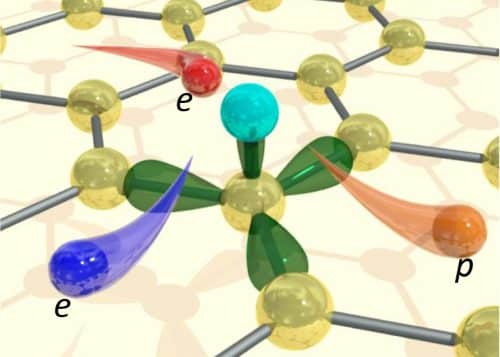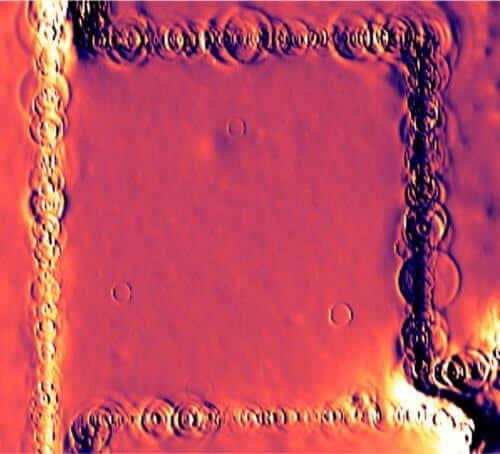Extremely precise measurement of the energy released by electrons in graphene reveals a new heating mechanism on an atomic scale

Graphene, a type of carbon that recently won its discoverers a Nobel Prize, may one day form the basis for environmentally friendly and extremely efficient electronic devices. Unlike other materials made of carbon, such as diamond, graphene conducts electricity - and as with most conductors, heat is a byproduct that must be taken into account in any future design that may include graphene. A study by scientists from the Weizmann Institute, ShAppeared recently in the scientific journal Science, Describes for the first time a mechanism by which electrons in graphene release heat. Understanding this mechanism may help engineers and researchers improve the design of graphene-based materials and devices, as well as provide a closer look at a microscopic-scale process that has yet to be explored.
"Graphene is a two-dimensional lattice of carbon atoms that looks like a honeycomb," explains Dr. Dori Halbertal, currently a post-doctoral researcher in the laboratory of Prof. Eli Zaldov In the Department of Condensed Matter Physics. "In clean graphene, there is apparently nothing that will 'attract the attention' of the electrons passing through it - and cause them to release their excess energy." Still, heat is emitted - and in particularly small devices, heating, even the slightest, may be a serious problem. If so, how is heat produced in "ideal" materials of the graphene type?
Sensitive thermal measurement

To examine the question at the atomic level, Dr. Halbertal and Prof. Zaldov teamed up with Dr. Moshe Ben-Shalom and Prof.Andre Game From the University of Manchester - from the graphene explorers - who have exceptionally clean graphene samples, in which the graphene is placed between two thin layers of an inert material, meaning that it does not react to chemical processes. Prof. Zaldov and the members of the group used a unique measurement system they developed, based on superconducting devices for quantum interference (SQUID). The system is contained in a large tank on top of a concrete structure weighing about two tons and supported by pneumatic legs, and is cooled with liquid helium to about 4 degrees Kelvin - all in order to isolate it from any environmental disturbance. The heart of the system is a device consisting of a thin lead-coated quartz needle - a metal that becomes a superconductor when cooled, and at the end - a ring that is only a few tens of nanometers wide, and it is the one that scans the properties of the material very close to its surface, but without touching them.
The device was originally designed to measure tiny disturbances in magnetic fields in materials, but Prof. Zeldov and Dr. Halbertal recognized its sensitivity to changes - even the slightest - in temperature, and decided to use this sensitivity for their research needs. In a previous study thatReleased in the scientific journal Nature About a year ago, the group demonstrated the device's capabilities in measuring temperature changes with an accuracy of one million degrees Kelvin - meaning the measurement system is ten thousand times more sensitive than other leading methods. The unique measurement technique allows the researchers to turn heat dissipation off and on at certain points in the graphene lattice - that is, not only to measure different aspects of heating on an atomic scale, but also to control them.
New heating mechanism

In the current experiment, the researchers found that the electrons released heat only at a few atomic sites within the graphene structure and at a large number of points along the edges of the structure. These observations allowed them to define the exact locations where the heat was coming from. "These sites are atomic defects, probably hydrogen atoms that have attached to the carbon lattice," says Dr. Halbertel. "These defects act like a trap: they can store the electrons inside them for a while before they escape after emitting a little energy in the form of heat."
The locations of these atomic defects appeared in the images obtained in the experiments as surrounded by rings. From an analysis conducted by the researchers, together with Prof. Leonid Levitov From the Massachusetts Institute of Technology, it emerged that the rings - narrow areas where there is an increased release of energy - are related to a previously unknown heat release mechanism; The mechanism involves a certain energy state needed for the electron to allow the release of heat.

The insights provided by this research may serve physicists, materials scientists and engineers who work with graphene. Moreover, Dr. Halbertal believes that the measurement method, which operates with a much higher resolution than any other method, may in the future enrich scientific knowledge in the field of the basic physics of heat release. "Many processes in various scientific fields, from biology to supernovae, involve the exchange and conversion of energy," says Prof. Zeldov. "With this method, we can understand how the energy dissipation occurs at the level of the single electron."
See more on the subject on the science website:
